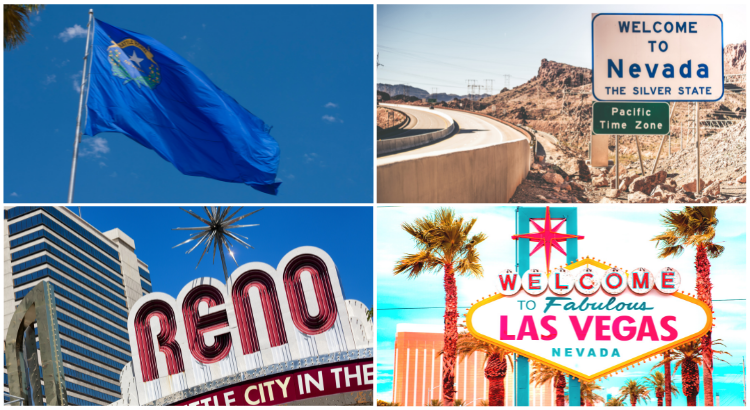Growing up in Las Vegas, the history lessons that stuck with me were less about the State of Nevada (sorry, Mr. BeDunnah, my Nevada History Teacher at Fremont Junior High!) and more about local (and modern) Vegas history (hello, Rat Pack!) So in honor of Nevada Day holiday, here’s some interesting Nevada trivia for you!
Here are a few basic things to know about Nevada should you find yourself on Jeopardy and the category is “Home Means Nevada” (and BTW – It’s Nev-AD-a not Nev-AH-da).
- State Flower – Sagebrush (this cannot be surprising to anyone.)
- State Fossil – Ichthyosaur (a water dwelling dinosaur. The area hasn’t always been desert.)
- State Song: Home Means Nevada (check it out and sing along!)
The Beginnings
Before European contact, American Indians of the Paiute, Shoshone, and Washoe tribes inhabited the land that is now Nevada. Today, thirty-two Indian Reservations and Colonies stretch across the state. When the Europeans did arrive, they chose the name “Nevada” which means “snow-covered” (yes, you read that right. snow. covered.). These particular Europeans were Spanish and gave the region this moniker because of the snow which covered the mountains in winter like the Sierra Nevada (“snow-covered mountains”) in Spain.
Nevada became the 36th state on October 31, 1864. The longest morse code telegram ever sent was the Nevada state constitution. Sent from Carson City to Washington D.C. in 1864. The transmission must have taken several hours. Eight days before the presidential election of 1864, Nevada became the 36th state in the union, despite lacking the minimum requisite 60,000 residents in order to become a state. (At the time Nevada’s population was little more than 10,000.) Why the urgency? The Civil War. The United States wanted to claim the Nevada Territory before the Confederate States could. So, rather than sending the Nevada constitution to Washington by Pony Express, the full text was sent by telegraph at a cost of $4,303.27, the most costly telegraph on file at the time for a single dispatch. The response from Washington came on October 31, 1864: “the pain is over, the child is born, Nevada this day was admitted into the Union.” Hence, why Nevada’s state motto is “Battle Born.”
Modern Times
Modern Las Vegas (queue the history that I learned) has continued its interesting past. In building up the surrounding area, construction worker hard hats were first invented specifically for workers on the Hoover Dam in 1933. As for all that water in the desert? Fountains and man-made lakes in Las Vegas use grey water, which is water recycled from showers, baths, and sinks.
What about the famous Las Vegas strip (the brightest place on earth and can be seen from space)? To kick things off, Bugsy Siegel named his Las Vegas casino “The Flamingo” for the long legs of his showgirl sweetheart, Virginia Hill. Today, on average, 300 couples are married each day in Las Vegas, making it the top wedding destination in the US. And on the flip side of that casino chip, Nevada is also a top destination for divorce and has been since the early 1900s when divorce attorneys around the country recognized the short residency and no-fault laws in Nevada a convenient answer to speedy action for their affluent clients. Even today, the residency requirement to apply for divorce remains at six weeks. And with Las Vegas the city with the most hotel rooms per capita, establishing residency is a breeze!

Other Burning Questions
But what about things like Area 51? Let’s be honest, you soooo wanted to ask! Well, Nevada is the seventh largest state with 110,540 square miles, 85% of them federally owned, which includes the secret Area 51 near the little town of Rachel. The existence of Area 51 is acknowledged with State Route 375 being officially christened “The Extraterrestrial Highway” in a ceremony featuring the director and cast of the movie “Independence Day.” Sounds a bit unreal, but I assure you, it is fact.
I would be amiss if let out the darker and notorious history of the state. The Mob has deep roots in Las Vegas and the development of this gambling playground (great exploration of it at The Mob Museum, located in what had been a federal courthouse and post office.) Segregation was severe in Nevada: top-billed entertainers of color were not allowed to stay at the hotels they were booked to perform, nor could they enter the casino floor after their sold-out shows. But there was one little hotel casino that could – located on the west side of the city, the Moulin Rouge was the first integrated hotel in the United States. And the Strip casinos did not appreciate the late night draw the casino drew (imagine not only Sammy Davis, Jr. hanging out there, but his buddies Sinatra, Dean Martin and others heading that way too. A fascinating and short lived history (it was only open for 6 months) that made a tremendous impact on integration in Las Vegas. Nevada was also the primary testing location of American nuclear devices from 1951 to 1992. During that time, 928 nuclear tests were performed at the Nevada Test Site just 65 miles northwest of Las Vegas. Of those, 828 were underground. Can you imagine swimming in your hotel pool on the Strip and watching a mushroom cloud ascend into the far desert sky? Atomic tourism was a thing! Learn more about it at the Atomic Testing Museum.
On a lighter note (literally), once a year, tens of thousands of people gather in Nevada’s Black Rock Desert to create Black Rock City, a temporary metropolis dedicated to community, art, self-expression, and self-reliance, but Burning Man derives its name from its culmination, the symbolic burning of a large wooden effigy, referred to as “The Man”.
What trivia or facts do you know about the Silver State? Drop me a line and share some knowledge!!

In addition to links above, facts about Nevada were mined from:
https://www.50states.com/facts/nevada.htm
https://localadventurer.com/nevada-facts/
https://www.usefultrivia.com/history_trivia/nevada_trivia.html
https://www.triviaplaying.com/436-Nevada-Trivia-Quiz.html
https://www.lasvegasadvisor.com/faq-general-divorce-history/
